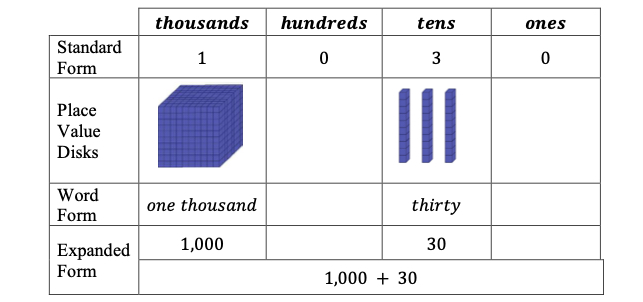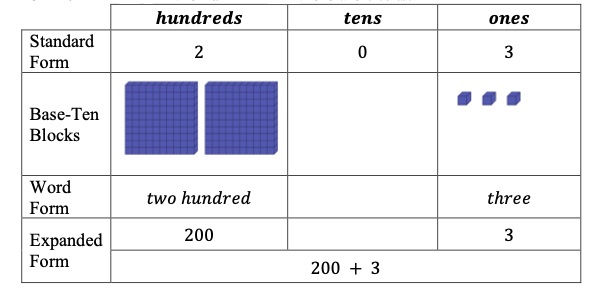Examples
The number two thousand five hundred thirty written in standard form is 2,530 and in expanded form is 2,000+500+30.Benchmark Instructional Guide
Connecting Benchmarks/Horizontal Alignment
Terms from the K-12 Glossary
- Expression
- Whole number
Vertical Alignment
Previous Benchmarks
Next Benchmarks
Purpose and Instructional Strategies
The purpose of this benchmark is for students to express numbers in standard form, expanded form, and word form. This work extends from the Grade 2 expectation to read and write numbers within 1,000 using standard form, expanded form and word form (MA.2.NSO.2.1).- Students learn to express multi-digit whole numbers using the place value of digits to name them in words. For example, two thousand five hundred thirty is named after the 2 in the thousands place, the 5 in the hundreds place, and the 3 in the tens place.
- Students express multi-digit whole numbers by decomposing them by place value and showing them as an addition expression with the value of each nonzero digit. For example, 2,530 is decomposed as 2,000 + 500 + 30.
- Decomposing numbers in expanded form helps students understand how addition and subtraction algorithms work, as well as helps them use the distributive property when multiplying multi-digit numbers (MTR.2.1).
- Throughout instruction, teachers should ensure students have practice with problems that include both vertical and horizontal forms, including opportunities for students to apply the commutative and associative properties. This will provide students opportunities to explain their thinking and show their work by using place-value strategies and algorithms. In addition to verifying that their answer is reasonable (MTR.3.1, MTR.6.1).
Common Misconceptions or Errors
- When the value of a digit in a multi-digit whole number is 0, students can misunderstand that it represents 0 of that place value. For example, in the number 2,530, there are 0 ones. In the number 1,008, there are 0 hundreds and 0 tens.
Strategies to Support Tiered Instruction
- Instruction includes using models and writing three- and four-digit numbers with a zero in various place values. A place value chart and models such as base-ten blocks or place value disks can be used to help students understand that when the value of a digit in a multi-digit whole number is 0, it represents a 0 of that place value.
- For example, in the number 1,030 there are 0 hundreds (beyond the ten hundreds represented by the 1 in the thousands place) and 0 ones (beyond the ones represented by the other digits).

- For example, in the number 203, there are 0 tens.

Instructional Tasks
Instructional Task 1
Instructional Items
Instructional Item 1
- a. 300 + 70 + 9
- b. 3,000 + 70 + 9
- c. 3,000 + 70 + 90
- d. 3,000 + 700 + 90
*The strategies, tasks and items included in the B1G-M are examples and should not be considered comprehensive.
Related Courses
Related Access Points
Related Resources
Lesson Plan
Student Center Activities
Tutorial
Student Resources
Tutorial
In this tutorial video from Khan Academy, learn to use an abacus to represent multi-digit numbers. This video will explain how the beads on an abacus can each represent ten times the value of the bead to its right.
Type: Tutorial
Parent Resources
Student Center Activities
In this game, students build the greatest or least possible number based on instructions by strategically placing digits as a team. They strengthen place value understanding while incorporating physical activity and teamwork.
FCR-STEM’s Count Us In! initiative is designed to support out-of-school providers and parents in fostering math success and enjoyment among K-5 children.
Type: Student Center Activity
In this game, students slide numbered caps strategically onto a place value chart to create the greatest or least number as they practice building and reading numbers to reinforce place value understanding.
FCR-STEM's Count Us In! initiative is designed to support out-of-school providers and parents in fostering math success and enjoyment among K-5 children.
Type: Student Center Activity
In this game, students use clues about correct digits and their placement to determine a secret number while they develop number sense through logical deduction, strategic reasoning, and place value discussions.
FCR-STEM: Count Us In! initiative is designed to support out-of-school providers and parents in fostering math success and enjoyment among K-5 children.
Type: Student Center Activity
Tutorial
In this tutorial video from Khan Academy, learn to use an abacus to represent multi-digit numbers. This video will explain how the beads on an abacus can each represent ten times the value of the bead to its right.
Type: Tutorial









